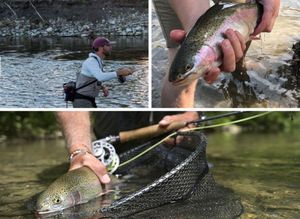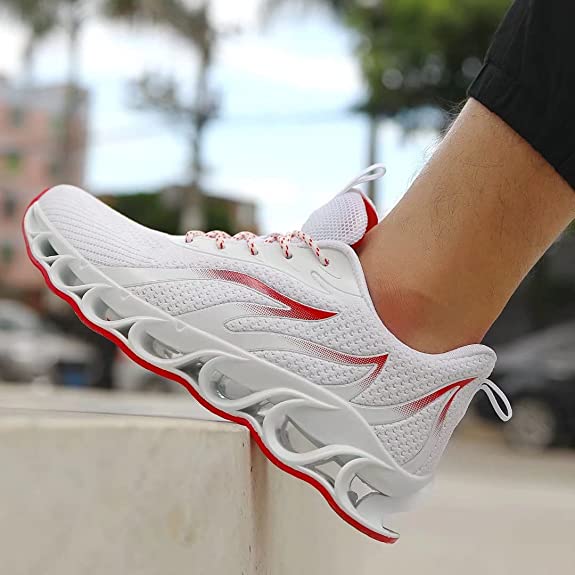Running is a simple and effective way to stay fit, but it's crucial to ensure that your gear, especially your running shoes, is in top condition. Knowing when to replace your running shoes can prevent injuries and keep your running performance at its peak.
Key Takeaways:
- Understanding the signs of worn-out shoes can help prevent injuries and maintain running efficiency.
- The lifespan of running shoes varies based on mileage, running style, and shoe quality.
- Incorporating multiple pairs of running shoes can extend shoe longevity and enhance the running experience.
Recognizing the Signs of Worn-Out Shoes
One of the key signs that it's time to replace your running shoes is the wear pattern on the soles. Worn soles with diminished tread can lead to slipping and increased injury risk. Additionally, if the midsole feels compressed and lacks cushioning, it's a telltale sign that the shock absorption properties are compromised.
Another indicator is the upper part of the shoes. If you notice that your shoes develop holes or the material is fraying, especially near areas of high stress like the big toe or heel, it's a clear signal that your shoes are past their prime. This can lead to hot spots, new blisters, and discomfort during runs.
Mileage: A Runner's Measuring Stick
Most shoes have a general mileage range after which they start to lose their structural integrity. For long-distance road runners, this is typically between 300 to 500 miles. Garmin Connect and similar apps can help you track your total mileage, making it easier to know when you're approaching the threshold for your current shoes.
However, mileage isn't the only factor. Off-road runners or hill runners might find that their shoes prematurely wear out due to the demanding terrain. In such cases, even if the mileage isn't high, the shoes might need replacing sooner to ensure proper support and injury prevention.
The Impact of Running Style and Foot Strike
Your running gait and foot strike play significant roles in how your shoes wear down. Runners with a neutral gait and even wear might get more miles out of their shoes compared to those with uneven wear due to overpronation or supination. A gait analysis at running stores can provide insights into your running mechanics and help you choose shoes that cater to your style.
Moreover, the location of most wear on your shoes can indicate your foot strike. For instance, if the outsole tread on the heel is significantly worn, it suggests a heel strike pattern, which may increase the rate at which you need new running shoes due to the greater impact on the heel cushioning.
Shoe Quality and Design: Do They Matter?
Absolutely! Shoe quality and design are pivotal in determining shoe longevity. High-quality materials and robust shoe design can withstand more wear and tear, delaying the need for a new pair. Minimalist shoes or 'super shoes' with advanced technology might offer different lifespans compared to traditional running shoes.
It's also worth considering that the same model of shoe can vary depending on the manufacturing batch. Always inspect new shoes carefully, even if they're the same model you've always worn, to ensure they meet your expectations for shoe quality.
The Role of Running Terrain in Shoe Longevity
Have you ever considered how the terrain you run on affects the lifespan of your running shoes? It's a big deal, and here's why: running on rough, off-road trails can accelerate the wear and tear on your shoes compared to smooth, paved paths. The rugged terrain can scuff up the outsole and stress the shoe's materials, leading to a quicker breakdown. This means that if you're an off-road enthusiast, you might find yourself heading to the running store more often than your road-running counterparts.
On the flip side, sticking to the pavement isn't a free pass to eternal shoe life. Hard surfaces can also increase the risk of compressing your running shoe's midsole, especially if you're clocking high mileage. The key takeaway? Pay attention to the surfaces you frequent and consider choosing a shoe type designed specifically for that terrain. Trail shoes for the off-beaten paths and road shoes for the cityscapes can make a significant difference in how long your running shoes last before they're considered worn-out shoes.
The Influence of Off-Road Running on Shoe Durability
When we venture off the beaten path and onto trails, the durability of our running shoes is put to the test. Off-road running introduces a variety of surfaces, from rocky paths to muddy tracks, which can accelerate the wear and tear on your footwear. The rugged terrain can cause the outsole to break down faster, and sharp rocks or roots can damage the upper part of the shoe. This means that if you're an avid trail runner, you might find yourself replacing your running shoes more frequently than those who stick to smoother surfaces.
Moreover, the increased risk of slipping and the need for more aggressive traction on off-road surfaces can lead to a different kind of stress on your running shoes. The lugs designed for grip can wear down quickly, and the protective features that shield your feet from trail hazards can also deteriorate. It's crucial for off-road runners to monitor their shoes closely and consider a pair specifically designed for trail running, which typically offers more durable materials and construction to withstand the demands of off-road conditions.
How Off-Road Conditions Increase Risk of Injury and Shoe Damage
Running off-road can be an exhilarating experience, but it also increases the risk of injury if your shoes aren't up to the task. Uneven terrain requires more stability and support from your footwear to prevent ankle rolls and other mishaps. When the structural integrity of your running shoes is compromised due to excessive wear, the risk of injury can climb, as your feet and ankles no longer have the necessary support. This is particularly true for shoes that have worn down unevenly, as they can alter your natural gait and lead to strain or injury.
Additionally, the elements you face off-road can contribute to quicker degradation of your running shoes. Water exposure from streams or puddles, for instance, can break down materials faster than in dry conditions. Mud and grit can get into the shoe, causing abrasion and weakening the fabric. For runners who frequently hit the trails, it's important to choose running shoes that are designed to resist these elements and to clean and dry them properly after each run to minimize damage and maintain their protective qualities.
Understanding the Relationship Between Shoe Fit and Wear
Did you know that wearing the wrong type of running shoe for your foot can not only cause discomfort but also contribute to the shoe wearing out prematurely? It's true! If your shoe doesn't fit properly—whether it's too tight, too loose, or just the wrong shape for your foot—it can lead to uneven wear patterns. This not only increases the risk of injury but also means you'll be shopping for new shoes regularly, which can be a hassle and an unexpected expense.
To avoid the pitfalls of a poor fit, it's crucial to get your feet measured at a specialized running store where experts can recommend the right shoe type for your unique foot shape and gait. A well-fitting shoe will not only feel more comfortable but will also distribute the impact of each stride more evenly, which can help extend the life of your running shoes. Remember, a new shoe that fits like a glove is worth its weight in gold for a runner's feet and their running journey.
The Benefits of Rotating Multiple Pairs
Running with more than one pair of shoes can be beneficial for several reasons. First, it allows each pair to rest and return to its original shape between runs, which can extend the life of your shoes. Second, using different shoes for different workouts, such as lightweight shoes for speed days and cushioned shoes for long runs, can improve running performance and reduce the risk of overuse injury.
Additionally, having two pairs means you can have a pair of shoes for different conditions – one for road running and another for off-road trails. This not only ensures that you have the proper support for each terrain but also prevents your road shoes from getting damaged by rough surfaces.
When New Aches and Pains Are a Red Flag
New aches and pains can be a red flag that your old running shoes are no longer providing the support you need. If you start to experience shin splints, knee pain, or new aches in your feet, it might be time to assess whether your shoes are the culprit. Often, replacing worn-out shoes can alleviate these symptoms.
It's important to listen to your body. If running feels tough on your joints or if you're developing hot spots or new blisters in unusual places, these could be signs that your shoes are no longer offering the cushioning and fit you need.
How to Extend the Life of Your Running Shoes
To maximize shoe longevity, it's essential to care for your shoes properly. Avoid exposing them to extreme temperatures, and give them time to air out after a run. Also, using your running shoes exclusively for running can prevent them from breaking down faster than they would from running alone.
Another tip is to untie your shoes before taking them off. Forcing your feet out can stress the shoe's structure and materials, leading to a loss of support and shape. Proper maintenance can make a significant difference in how long your shoes last.
Choosing the Right Time to Shop for New Shoes
Timing is everything when it comes to shopping for new shoes. It makes sense to start looking for your next pair before your old pair is completely worn out. This gives you a chance to break in your new shoes gradually without abruptly changing your running mechanics, which can lead to injury.
Moreover, shopping for new shoes while your old ones still have some life left allows you to compare the feel and fit. You can identify when the old shoes begin to feel different from the newer shoes, which is a practical way to recognize that it's time for a change.
Summary
Replacing your running shoes at the right time is crucial for maintaining your running performance and preventing injuries. Pay attention to the wear pattern, cushioning, and any new discomfort during runs. Keep track of your mileage, consider your running style and terrain, and invest in quality shoes that match your needs. Rotating multiple pairs can extend the life of each and provide variety for different workouts. By staying vigilant and proactive, you can ensure that your feet are always equipped with the proper support they need to keep you running strong. If you want to replace your current shoes with what I think are the best on the market then check out this article on the Mosha Belle shoe I like the most.
FAQ Section
Q: How many miles should my running shoes last? A: Most running shoes last between 300 to 500 miles, but this can vary depending on your running style, the shoe quality, and the surfaces you run on.
Q: Can I extend the life of my running shoes? A: Yes, by caring for them properly, using them only for running, rotating between multiple pairs, and avoiding extreme temperatures, you can extend the life of your running shoes.
Q: How do I know if it's time to replace my running shoes? A: Look for key signs like worn soles, diminished cushioning, uneven wear, and new aches or pains. Also, keep track of your mileage and how your shoes feel compared to newer models.






